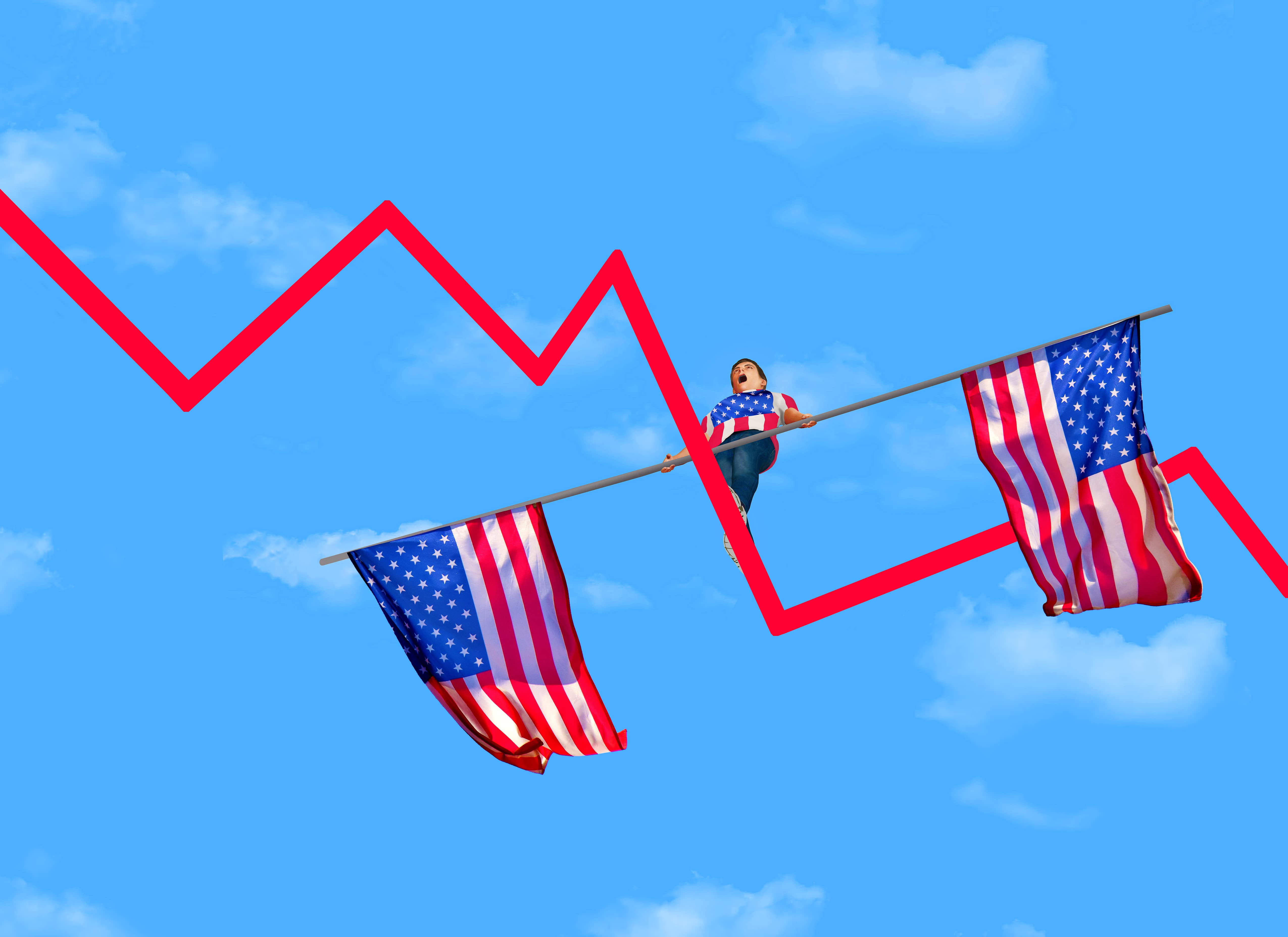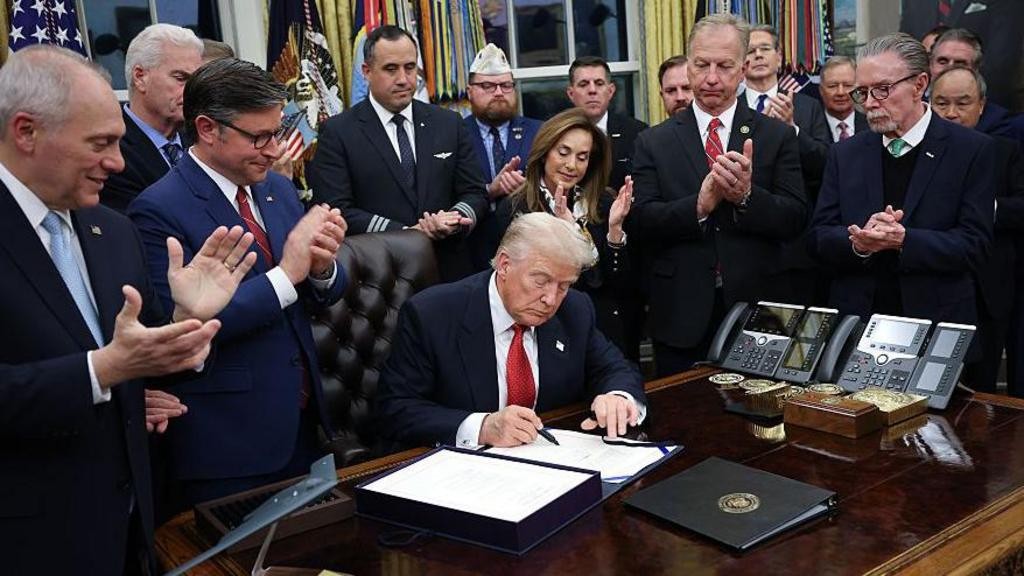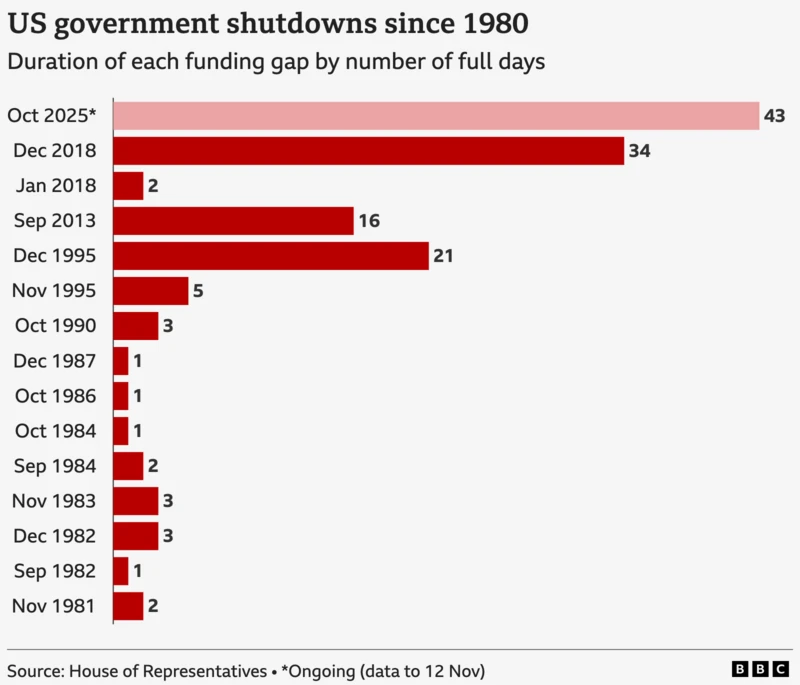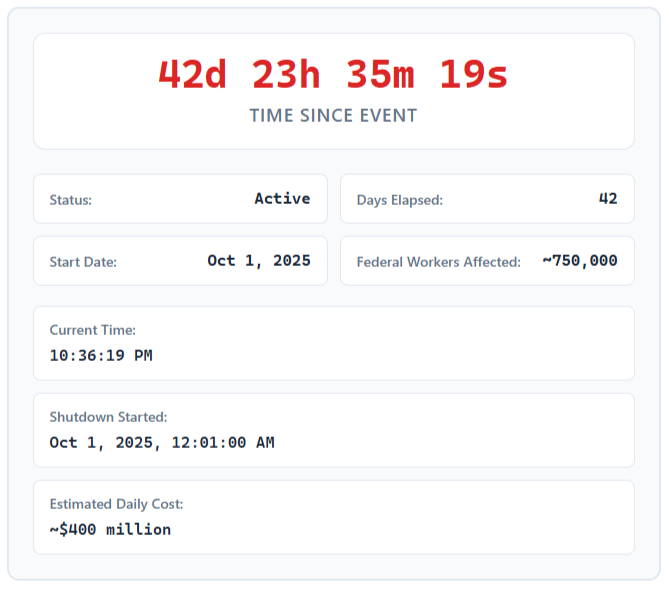市场资讯及洞察

The longest government shutdown in US history has finally ended after 42 long days.
After a month and a half of political theatre, seven Democrats and one independent broke ranks and voted with Republicans to pass a stopgap measure. The Senate went 60-40, the House followed 222-209, and Trump signed it hours later.
The legislation includes three-year appropriations for the Agriculture Department, FDA, military construction, veterans affairs, and congressional operations, along with restoration of pay for federal workers and reversal of Trump administration layoffs through January.
However, the most contentious issue, healthcare subsidies, has been kicked down the road to a December Senate vote.

COVID-era ACA subsidies expire at year-end. When they do, premiums for the average subsidised household will more than double from $888 to $1,904 per year, with an estimated 3.8 million people losing coverage entirely.
If the December vote fails, which is likely considering how far apart the two parties are on the topic, we could see a new shutdown begin in January.

What Happens Next?
This Week:
- Federal employees return to work.
- Paychecks start flowing again.
- SNAP benefits get restored for 42 million people, though heating assistance won't come back for weeks.
- National parks reopen.
- Airports start to go back to normal.
December:
- Senate votes on healthcare subsidies. It will probably fail.
- Premium notices continue to be sent showing 2026 costs doubling.
January 30:
- Government funding expires.
- We do this whole thing over, except now the healthcare subsidies have already expired.
- If Republicans and Democrats remain divided on budget priorities, another shutdown will likely begin.
By the Numbers:
Over the past 42 days, approximately 750,000 federal workers have been furloughed. Another two million worked without pay. Over 42 million had their food assistance delayed. And the FAA cut flights by 10% because air traffic controllers stopped showing up to work.

Further concern is the "data blackout" that has hampered Federal Reserve decision-making. Key economic indicators, including jobs reports, were suspended, leaving the Fed blind during an active rate-cutting cycle.
Meanwhile, separate analyses from Challenger, Gray & Christmas showed layoffs surged 183% in October, which would make it the worst October for jobs since 2003.
The Bottom Line
Today’s deal ended the shutdown, but it didn’t actually solve anything. The deal essentially kicks the can down the road to January while leaving the healthcare crisis unresolved.
With both parties divided on healthcare and spending priorities, and Trump lacking a comprehensive plan to address rising premiums and high deductibles, a resolution in the December vote seems unlikely.
If no compromise is accepted by the time Government funding expires on January 30, another shutdown is almost inevitable.
Impact of Australian Jobs Reports and U.S. Shutdown End on the Aussie


Without any doubt it was a difficult year for the stock markets. Recently nearly all equity indices have erased their 2018 gains. October has also lived up to its reputation in being the worst month for equities.
The stock markets bled red, and investors were anxious and cautious. The equity markets have gone through their longest bull run, and markets participants were only expecting a correction of 10% at some point. However, the recent massive sell-off prompted increased fears as the markets were navigating into a sea of headwinds, with growing concerns that it is more than just the markets correcting themselves.
Has Jerome Powell emerged as the saviour? The policy divergence between the US and the other major central banks was the dominant driver that had altered the spectrum of the buoyancy in the markets at the beginning of the year. A hawkish Fed prevented the equity markets to outperform in 2018.
A sudden dovish shift whereby a few Fed officers appeared to be less hawkish has captured the markets’ attention. Chairman of the he Federal Reserve, Jerome Powell’s comments were the trigger: “ interest rates are close to neutral ” compared to “interest rates are a long way from neutral” which were embraced by equity traders. Wall Street slowly moved into green again as the possibility of fewer rate hikes boosted equity benchmarks: The Dow Jones Average Industrial surged by 600 points to close at 25,366.43 S&P500 jumped by 2.3% to finish at 2,743.79 Nasdaq Composite advanced by 2.95% to end at 7,291.59 Jerome Powell appears to have just put a floor under stocks!
Source: Bloomberg Is the renewed optimism justified? It would make sense to say “yes” as the Fed risk has resolved itself and now the markets have “one less” headwind to think about. When the markets dropped as much as 10%, such dovish news is deemed favourable as it plays an essential part to the bottoming process.
However, while the change in language does indicate “dovishness” and be the reason for the market to cheer up, the price action might be exaggerated or could lose steam as trade tariffs with China is far from resolved even though there is more optimism regarding trade negotiations. The stock markets are still fragile and vulnerable to: Peaked earnings Slow growth in China Reduction in global demand Brexit jitters The rout in oil markets Regulatory measures We have also seen that technology investors had a rough two months having witnessed the FAANG group wiping off $1 trillion in market value. Fundamental and external risks have forced investors to stop and think.
Apple shares fell in a bear market territory shaking up the technology sector this month. Being the bellwether of technology stocks, the rout in Apple shares over the decrease in iPhone sales put downward pressure Wall Street. Apple erased $190 billion in five weeks and it lost its $US1 trillion valuation.
Trump tariffs threat on iPhones did little to help Apple in staging a recovery. Source: Bloomberg If it were not for the relief bounce in late November, Amazon was down by 21% since the first of October losing $200 billion market cap at some point. Fundamentals are not flashing red signals that justified such a massive sell-off.
The stock’s recent decline may be an overreaction, but it appears that fears were elevated after the disappointing revenue forecasts. Source: Bloomberg Other big stocks in the FAANG group are facing regulatory headwinds and concerns over the valuations of such big names. Regulation has just started to come down on companies and will likely get tougher.
These highflying stocks have grown so large that institutional investors are wary to go back to that overweight position. Are investors seeking more large-cap value over large gap growth? Overall, the equity markets were mostly hit by two major headwinds: Higher rates and Trade tariffs.
Now that Powell cleared investor’s doubts regarding interest rate. The attention now moves to the G20 summit. Traders are contemplating different scenarios on how the summit will unfold.
The most likely situation given the conflicting news from the White House will be that: Both parties will announce some kind of negotiation to somewhat calm the markets, but the US will most probably increase tariffs as expected. Whether the Stock Market will end in the green or still be flashing red, it may very well depend on President Trump.


The World Economic Outlook has further shifted to the downside. The growth estimates for 2019 and 2020 were downgraded in October 2018 mainly due to trade tensions. The recent further downward revisions were the result of the weakening momentum in key industrialised economies.
The table below depicts the “Weakening Global Expansion”: The outlook for Developed Economies Eurozone Area: The most significant revisions came from Europe- mainly Germany and Italy. Germany is experiencing weakness in the auto industry, following new fuel emissions standards and soft private investment. Italy is facing weak domestic demand and high borrowing costs.
France is being dragged by yellow vest protests and weak industrial production. In addition to the above, the rise in populism in the Eurozone area, Brexit and cross-border spillovers are some other Europe-specific factors that are weighing on economic activity. United States: Washington is in gridlock, and the fiscal sugar rush died down.
The US expansion continues, but growth momentum will soften. In comparison with the Eurozone area, the US’s growth will remain high. The prolonged US government shutdown is also posing risks to economic activity.
Japan and the United Kingdom: Despite natural disasters in Japan and Brexit in the UK, IMF has upgraded growth forecasts for these two economies. Japan’s fiscal support and mitigating measures to the tax hike enabled the IMF to revise the estimates to the upside. Given that the uncertainty around Brexit is eliminated and a deal has been reached, the UK economy is expected to move up because data has shown that it is not as sluggish as the Eurozone area.
The Outlook for Emerging & Developing Economies China: Despite the recent stimulus program which will tackle some of the impacts of trade frictions, China’s economy is forecasted to slow towards the lower range of 6%. A combination of financial regulatory tightening, trade dispute and rout in commodity prices have caused a deeper slowdown than initially forecasted. The warnings from IMF is a reminder that China’s slowdown will have a global impact.
Saudi Arabia: Tumbling oil prices have forced IMF to also lower growth forecasts for Saudi Arabia. India and Brazil: “India’s economy is poised to pick up in 2019, benefiting from lower oil prices and a slower pace of monetary tightening than previously expected, as inflation pressures ease.” The main factor behind the revisions is the declining commodity prices, which will eventually aid policy easing. Brazil’s recovery is expected to continue, which allowed IMF to upgrade its forecasts.
These moderate downward revisions to forecasts which were already revised down in October 2018 are warnings that investors will be keen to keep an eye on. IMF stretched the importance of recognising the growing risks, even though we are not anticipating a significant downturn at this stage. This may be the reason why the World Economic Outlook is placing more emphasis on the Multilateral Cooperation, and call for policies as well to reverse the current headwinds and prepare for the forecasted downturn.
As of writing, the concerns about the global economic outlook have resurfaced with IMF warnings and its impact on risk sentiment can be seen in the Asian markets today.


It might be difficult to stay optimistic in such plunging markets. Global equities are in a bear market and investors are moving away from riskier assets. Amid the mayhem, there may still be some buying opportunities if investors are selective about certain stocks.
We are facing a global pandemic that is slowly forcing major countries into lockdown and halting global activity. Investors are therefore tapping into sectors that offer bargains or where they see long-term growth opportunities. The health care sector seems to be on investors’ watchlists.
It should be highlighted not all health care stocks are performing the same way. Our attention turns to two stocks that have so far outperformed amid the coronavirus outbreak. Moderna Inc (NASDAQ: MRNA) In the US markets, Moderna Inc. is standing out.
As several companies are racing against time to create a vaccine for the COVID-19, Moderna Inc. is among the first to develop a vaccine against coronavirus. For a relatively young and small company, the Massachusetts-based biotechnology firm has performed its first human trial of the coronavirus vaccine on Monday. Ever since they received funding from the CEPI to accelerate the development of messenger RNA Vaccine against the novel coronavirus, the biotech company became popular among investors.
Moderna Inc. is among the best-positioned mRNA company with 16 Phase 1 trial started and five out of their first five modalities demonstrating success in the clinic. As of writing, the company’s share price is currently trading at $26.57 after reaching an all-time high of $31.48 last week. Source: Bloomberg Terminal For the past month, the company’s share price is currently up by more than 40%!
The coronavirus vaccine could be a key turning point for the success of Moderna, which is yet to produce a proven product on the market using its mRNA technology. Share Price & Information Moderna, Inc. is a Cambridge, Massachusetts-based biotechnology company focused on drug discovery and drug development based on messenger RNA (mRNA). In January, Moderna announced the development of a vaccine to inhibit COVID-19 coronavirus.
NASDAQ Profile NASDAQ:MRNA Market Cap: 8,741,616,884 Today's High/Low: $29.81/$26.25 Get in touch with your account manager to find out how you can start trading Moderna Inc today. Don't have an account? Sign up here.
Fisher & Paykel Healthcare Corp Ltd (ASX:FPH) In the Australian share market, Fisher & Paykel Healthcare Corp Ltd is among the best performers. The company is a manufacturer, designer and marketer of products and systems for use in respiratory care, acute care, and the treatment of obstructive sleep apnea. Fisher & Paykel Healthcare’s share price added above 40% since the widespread of the COVID-19 (Year to Date).
With a rise of 85% in the last 6 months, the company is currently the best performing stock of the S&P/ASX200. Back-to-Back Upgrades While most companies are downgrading forecasts in this bear market environment, the company has issued two upgrades since the beginning of the year. Vitera, a new full face mask used in the treatment of obstructive sleep apnoea has outperformed in the early stages.
The company also received clearance to sell the mask in the US sooner than expected which contributed meaningfully in driving its share price to new record highs. The company also delivered a strong financial performance for the six months to 30 September 2019: Net profit after tax was up by 24% at $121.2million Operation revenue rose by 12% at $570.9 million The COVID-19 outbreak has substantially increased demand for certain products, which has enabled the company to upgrade its revenue and earnings guidance for the financial year ended 31 March 2020 a couple of times since January. Taking into consideration exchange rate revisions, the company is now expecting: Full-year operating revenue to be approximately $1.24 billion instead of $1.19 billion in November’s guidance.
Net profit after tax to be within the range of approximately $275 million to $280 million instead of approximately $255 million to $265 million back in November. On the supply side, the fact that the company does not have a manufacturing facility in China, they are not expecting major supply disruptions. Overall, the company is also making progress with other major initiatives and is establishing a presence in more countries while undertaking numerous other studies.
The continuous growth of Fisher and Paykel in the near and medium-term is looking promising.


Hawkish and Dovish are two crucial words widely used in our industry whenever there are central bank speeches or talks about monetary policies. But what does it mean? Central banks are more transparent than ever and forex analysts or traders try to dissect the overall tone and language used when central bankers speak to see: How the economy is flaring How interest Rate will change or foresee How the monetary policy will develop over time and affect the value of a country’s currency A hawkish tone means that a central bank is seeing the economy growing too fast and is warning the markets of excessive inflation.
Therefore, to curb inflation and slow economic growth, central banks might increase interest rate which will be positive for the domestic currency. A dovish tone is a complete opposite – The economy is not growing and the central bank is warning against deflation. In other words, there might be interest rate cuts to stimulate the economy which is negative for the domestic Currency.
Put simply, when there is a Hawkish tone, there are talks about tightening monetary policy which will probably lead to interest rate hikes. On the other side, a dovish central bank will use easing or accommodative monetary policy which will result in interest rate cuts. Recently, Major Central Banks of Key economies have turned dovish due to slowing global growth and this week the Reserve Bank of New Zealand joined the dovish chorus as well.
This article is written by a GO Markets Analyst and is based on their independent analysis. They remain fully responsible for the views expressed as well as any remaining error or omissions. Trading Forex and Derivatives carries a high level of risk.


Liquidity Crisis High levels of liquidity happen when there is both supply and demand for an asset, meaning transactions can take place easily. A market is considered to be liquid if it can absorb liquidity trades with significant changes in price. A liquidity crisis is, therefore, an acute shortage or drying up of liquidity.
In simple terms, it occurs when there is a simultaneous increase in demand and a decrease in the supply of liquidity across many financial institutions or businesses. As the impact of the coronavirus has rattles markets, global central bankers and governments are ramping up efforts to address liquidity issues across markets. Gold – A Highly Liquid Asset In times of uncertainties, investors generally seek safety with traditional haven assets like Gold.
Why is Gold also selling off? Gold is set apart as it has a feature of a liquid asset just like cash. Investors are on the hunt for liquidity which is prompting the gold market sell-off.
An environment of thin liquidity and high volatility is forcing investors to unlock capital in gold to fulfil liquidity requirements. Gold was seen outperforming this year which makes it a profitable asset- prompting investors to take profit. As the turmoil in global stocks intensifies, investors are looking for ways to cash in to meet margin calls.
At the same time, the safe-haven status of the gold is being hammered by a stronger US dollar. Despite the Fed’s bold emergency rate cuts, the greenback made an impressive comeback against its peers. Another wave of global easing hits markets, making the US dollar the preferred choice compared to other major currencies.
The unusual tandem between the US dollar and Gold seen since the beginning of the year seems to have also faltered at the start of March. Gold has recently lost some of its haven appeal as investors search for liquidity, but it has remained around elevated levels seen in the past 12 months. On Tuesday, reports of a big stimulus package of more by $1 trillion have helped the gold to rebound slightly Source: Bloomberg Terminal Gold Stocks Gold is a victim of the sell-off because of its outperformance and liquidity features which are beneficial to investors during times of financial crisis.
However, gold miners’ stocks have the potential to rally in anticipation that the price of precious metals will go up once the markets stabilise. In the Australian share market, the rebound on Tuesday was mostly driven by the gold mining stocks, which surged by more than 15% despite a fall in gold price. Source: Bloomberg Terminal It is therefore not uncommon for gold to act as a source of liquidity at the start of a liquidity crisis.
As investors are convinced that central banks’ intervention measures like rate cuts and quantitative easing will inject enough liquidity in the financial market, Gold will likely find buyers.


In the wake of the global financial crisis, the G20 summit has become a popular forum of global governance and cooperation. In the heat of the disaster, G20 members came together to sustain global financial stability. The G20 has been a useful pool of information and decision making that have steered the global financial markets since 2008.
G7 Summit The Group of Seven consists of the most industrialised and advanced countries in the world representing 58% of global net worth and 30% of the world’s economy. The G7 Summit focuses on the broader array of economic and political challenges. G20 Summit The financial crisis in 2008 recognize the era where countries need to seek more cooperation among themselves to promote a sound global financial system.
Therefore, the G20 is primarily dedicated to international economic cooperation and allows China, India and other emerging nations to take a more significant global role. It acknowledges the shift towards emerging economies. G20 accounts for 84% of global investment and 63% of the world’s population.
Argentina has set “Building Consensus for fair and sustainable development” as the slogan for the leaders’ summit this year concentrating on three key priorities “ the future of work, infrastructure for development and food security. ” However, protectionism measures have been the main talks ahead of the summit. In the meeting in Bali earlier this year, all the members agreed that heightened trade and geopolitical tensions are among the most critical downside risks in the short and medium term. The G20 summit is, therefore, the “Golden Opportunity” for Trump and other leaders to engage in trade talks.
Face- to face meetings might be better to ease trade frictions. As of writing, news that China has outlined a series of trade concessions are emerging. Hence, investors are optimistic that the G20 meeting might bring more positive news than anticipated couple of weeks before given that the US-China decided to restart trade negotiations.
The Summit has the potential to move the financial markets, and any headlines will likely go under intense scrutiny. Mark Your Calendar – 30 November – 01 December!! *Follow us on Twitter for more updates regarding the upcoming G20 summit

